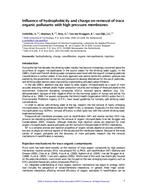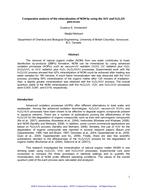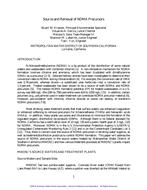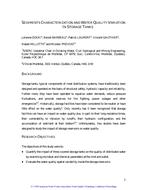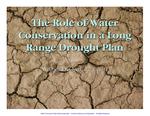Provide PDF Format
AWWA WQTC63981
- Influence of Hydrophobicity and Charge on Removal of Trace Organic Pollutants with High Pressure Membranes
- Conference Proceeding by American Water Works Association, 11/01/2006
- Publisher: AWWA
$12.00$24.00
The objective of this study was to assess the influence of both hydrophobic-hydrophobic and chargeinteractions on the rejection of selected trace organic pollutants. In order to experimentally generate the rejection values, bench-scale laboratory experiments werecarried out. Trisep 4040 TS80-TSF spiral-wound nanofiltration membrane elements were used for all experiments. In order to investigate the influence of solute-hydrophobicity on the rejection, three differentcategories of uncharged solutes were selected, based on their log K<sub>ow</sub>-value: hydrophilic molecules(log K<sub>ow</sub><1), hydrophobic molecules (log K<sub>ow</sub>>3), and a category of solutes of intermediatehydrophobicity (1<log K<sub>ow</sub><2). Compounds of increasing molecular weight were chosen, to constructrejection curves in function of molecular weight. Some interesting trace organics (e.g. NDMA andMTBE) however, were also included in the testing.In order to investigate the influence of charge, several pharmaceuticals were selected, based on theirmolecular weight and charge. Positively and negatively charged pharmaceuticals were selected, aswell as some neutral pharmaceuticals. All organic contaminants were analyzed by GC/MS (gas chromatography, combined with massspectrometry) or LC/MS (liquid chromatography, combined with mass spectrometry). The feed watermatrix for the filtration experiments with the neutral compounds was Milli-Q water. For thepharmaceutical experiments, surface water from the Weesperkarspel treatment plant in Amsterdam(DOC-content 5 mg/l) was used. Compounds were spiked into the feed waters in concentrations of 2µg/l. A bench-scale, cross-flow membrane filtration test unit for 4040 membrane modules was used in thisstudy. The unit utilizes a multi-impellor centrifugal pump (Grundfos CRN 3) capable of providingpressures of up to 25 bar at a flow rate of 3 m<sup>3</sup>/h. Temperature of the feed tank was kept constant at20ºC using a cooling system (Tamson TLC 10B). Feed, permeate and concentrate flows weremonitored by rotameters. The bench-scale NF experiments were carried out at a recovery ofapproximately 10%. All test unit parts in contact with the solution are made of stainless steel tominimize adsorption of the organic solutes used.Bench-scale filtration experiments were performed at a constant cross-flow rate (Qf = 1500 l/h,cross-flow velocity = 0.2 m/s (which correspond to a concentration polarization factor of 1.02)) andtransmembrane pressure for 4 days at 20ºC and pH 7-8. Experiments lasted for 4 days toreach saturation of the membrane with the compound of interest, so no overestimation of the rejectionwas obtained. Samples of feed and permeate streams were taken for analysis of organic solutesconcentration.Before use, membranes were rinsed for 2 hours with tap water (to remove the preservation liquidspresent in the membranes) and characterized for MgSO<sub>4</sub>-rejection with a 500 ppm MgSO<sub>4</sub>-solution inMilli-Q water. Includes 12 references, tables, figures.
Related Products
AWWA WQTC71366
Comparative Analysis of the Mineralization of NOM by Using the VUV and H2O2/UV Processes..
$12.00 $24.00
AWWA WQTC50378
Sediments Characterization and Water Quality Variation in Storage Tanks..
$12.00 $24.00

